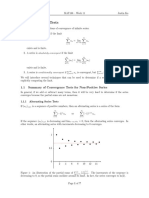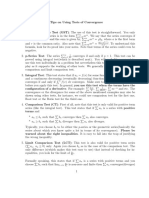Sequence and Series Basics
Uploaded by
Anushka SinghSequence and Series Basics
Uploaded by
Anushka SinghSequences and Series Cheat Sheet
by ebabor via cheatography.com/69500/cs/17544/
General Rules Tests (cont) When to Use Tests
Telescoping and Geometric series are the only Diverges If ∑bk diverges Properties If you can identify the series as a
types of series that you can estimate sums AND bk is smaller geometric, p, or telescoping
from. So, you must use these test's properties series, then use their respective
of two functions
to estimate these sums properties. If the given series
Limit Converges If bk converges
looks close to one of these
If the question is asking for absolute
Comparison AND limit of
convergence or conditional convergence. You series see if you can use
Test(LCT) 0<(ak)/(bk )<
will need to use the Ratio Test, Root Test, or algebra to rearrange it into
∞ one of them
the definition of Absolute/Conditional
Convergence Diverges If bk AND limit of
Test for Should at least eyeball this test
Must show ALL work to receive full credit for 0<(ak)/(bk )< Divergence( first to see if the limit of the
questions. Study the process to solve the ∞ TFD) series does not approach 0. If
problems, don't just guess through the review series does not approach 0,
Alternating Converges If all 3 conditions
then ∑ak divergent by TFD
Series for AST are met
Tests Test(AST) Comparison ONLY POSITIVE TERMS! If
Diverges If limit condition Tests(CT you can tell if the series has
Test for Inconclusiv You absolutely
fails, ∑ak is and LCT) negative terms,((-1) k or
Divergence( e cannot determine
TFD) if a series is immediately sin/cos), do not use this test. If
convergent from divergent by TFD series has is rational and has a
this test. root in the denominator,
compare with a p-series. |ak|
Diverges If limit of series ≠0 Properties of Special Series
gives use absolute
or ∞ Geometric Converges If Absolute Value of
convergence
Integral Converges If integral of series Series r<1. Converges at
Alternating Series with (-1)k can be testes
Test <∞ S=(first term)/(1-r)
Series with AST
Diverges If integral of series Diverges If Absolute Value of Test(AST)
=∞ r≥1
Integral ONLY POSITIVE TERMS! If
Ratio Test Converges/ If limit of 0≤| P-Series Converges If p>1 Test you can look at the function and
Converges (ak+1) /(ak)|<1
Diverges If p≤1 easily take the integral, it is
Absolutely
Telescopin Converges Value that the limit probably good to use this test
Diverges If limit >1
g of the remaining Ratio Test If series contains: k!, or powers
Inconclusiv If limit =1 terms approach and exponentials, almost
e Diverges Almost never. On guaranteed to use ratio test
Root Test Converges/ If 0≤limit of the kth the test it will
Converges root of |ak|<1 converge
Absolutely
Definition Absolute If and only if ∑|ak| is
Diverges If limit of the kth of Convergen convergent
root of |ak|>1 Convergen ce
ce
Inconclusiv If limit of kth root of
e |ak|=1 Conditional If and only if ∑ak is
Convergen convergent, but
Direct Converges If ∑bk converges ce ∑|ak| is divergent
Comparison AND bk is the
Test(CT)
larger of the two
functions
By ebabor Published 22nd October, 2018. Sponsored by ApolloPad.com
cheatography.com/ebabor/ Last updated 22nd October, 2018. Everyone has a novel in them. Finish Yours!
Page 1 of 2. https://apollopad.com
Sequences and Series Cheat Sheet
by ebabor via cheatography.com/69500/cs/17544/
When to Use Tests (cont) Alternating Series Remainder
Root If the entire series can be written to the Known Set error bound less than bn+1. Solve
Test kth power, you can use the root test Error for a #>n, round up n to next highest
Bound whole number
Integral Test If the inequality is very difficult to
solve, the use of a table, shown
Conditions:
below, is acceptable. When the
1. f(x) is positive on its interval
middle column, bn+1, is less than
2. f(x) is continuous on its interval
3. f(x) decreasing as x->∞ (derivative is third column, error bound, then that
negative) value is you final answer for n. Since
* Must change ak to a function in order to take the original variable in the equation is
derivative k, and k=n+1, then the value of the
* Integral starts off from k to ∞, so you must final term you can stop on to reach
change the integral to k to t with limit as t->∞ your error bound will be k
* Answer you get is not where the ∑ak
converges nth bn+1 Error Bound
term
Alternating Series Test
Conditions:
1. bk>0
2. bk≥bk+1
3. limit of bk=0
* If ∑bk fits all three conditions, ∑ak convergent
by AST
* If 3rd condition fails, ∑ak is divergent by TFD
* If series contains (-m)k, pull (-1)k out and keep
m k in bk
Integral Remainder
Known Solving for Sn(sum of Plug n into
nth the series the series
Value approximation)
Solving for Rn Solve
(approximation of the integral
remainder) from n to ∞
Known Set the integral of f(x) from n to ∞ less
Error than error bound. Once solved,
Bound answer will be given in terms of n<#.
Must round up the number since
series only use integers and if you
rounded down, the value of the
integral would be larger than the error
bound
By ebabor Published 22nd October, 2018. Sponsored by ApolloPad.com
cheatography.com/ebabor/ Last updated 22nd October, 2018. Everyone has a novel in them. Finish Yours!
Page 2 of 2. https://apollopad.com
You might also like
- Core+Review+Calculus+II+Exam+2+SolutionsNo ratings yetCore+Review+Calculus+II+Exam+2+Solutions63 pages
- Extra Exercises, Quizzes, Miscellaneous Notes: 1 X 1 1 X X !0 1/5 1/5 1/3 1/3 2 2 1 X !1No ratings yetExtra Exercises, Quizzes, Miscellaneous Notes: 1 X 1 1 X X !0 1/5 1/5 1/3 1/3 2 2 1 X !112 pages
- Topic 15 - Infinite Series and Its Convergence (Non-Negative Series)No ratings yetTopic 15 - Infinite Series and Its Convergence (Non-Negative Series)12 pages
- Definitions: Convergent and Divergent Series: S A A A ANo ratings yetDefinitions: Convergent and Divergent Series: S A A A A4 pages
- 1.3 The Integral Test and Estimates of SumsNo ratings yet1.3 The Integral Test and Estimates of Sums7 pages
- Sequence and Series: Gabriel Asare Okyere (PHD)No ratings yetSequence and Series: Gabriel Asare Okyere (PHD)27 pages
- Mathematical Techniques: Revision Notes: DR A. J. BevanNo ratings yetMathematical Techniques: Revision Notes: DR A. J. Bevan5 pages
- Sketch of Solutions To Problems For Calculus 1-3No ratings yetSketch of Solutions To Problems For Calculus 1-319 pages
- MATH 155, Prep-review for Chapter 9 TestNo ratings yetMATH 155, Prep-review for Chapter 9 Test22 pages
- Unit 9_ Infinite Sequences and Series - Key Concepts and TechniquesNo ratings yetUnit 9_ Infinite Sequences and Series - Key Concepts and Techniques3 pages
- Harolds Series Convergence Tests Cheat Sheet 2016No ratings yetHarolds Series Convergence Tests Cheat Sheet 20162 pages
- (Power) Series: Solved Problems Phabala 2010No ratings yet(Power) Series: Solved Problems Phabala 20106 pages
- Taylor Series, Power Series: Warning. Be Prepared To Prove Any of These Things During The Exam. Things You ShouldNo ratings yetTaylor Series, Power Series: Warning. Be Prepared To Prove Any of These Things During The Exam. Things You Should6 pages
- 9 - Absolute Convergence-The Ratio and Root Tests PDFNo ratings yet9 - Absolute Convergence-The Ratio and Root Tests PDF2 pages
- S. Ponnusamy (Auth.) - Foundations of Mathematical Analysis-Birkhäuser Basel (2012)100% (5)S. Ponnusamy (Auth.) - Foundations of Mathematical Analysis-Birkhäuser Basel (2012)587 pages
- UG Mathematics Syllabus (Under NEP-2020) - 2023-24No ratings yetUG Mathematics Syllabus (Under NEP-2020) - 2023-2417 pages
- 3-1: The N Term Test and Sum of A Series: 1 Homework QuestionsNo ratings yet3-1: The N Term Test and Sum of A Series: 1 Homework Questions2 pages
- Elementary Course of Infinitesimal Calculus100% (1)Elementary Course of Infinitesimal Calculus648 pages
- Curriculum and Syllabus Under Semester System: Bs (H) in MathematicsNo ratings yetCurriculum and Syllabus Under Semester System: Bs (H) in Mathematics43 pages
























































































